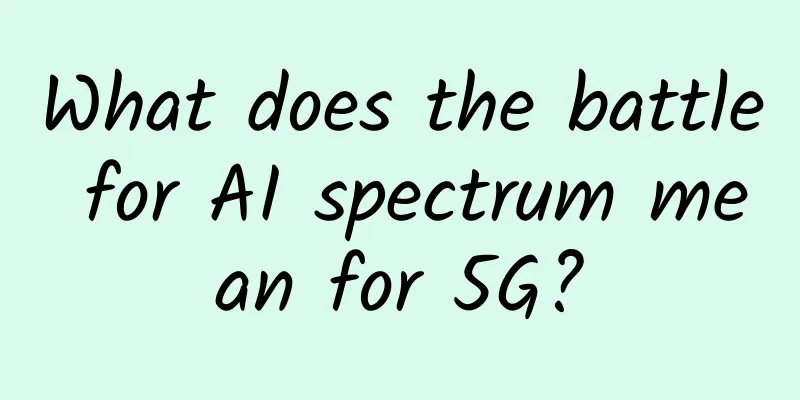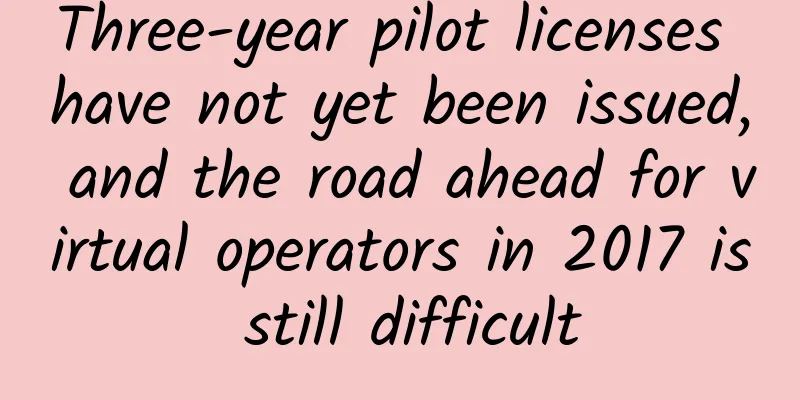What does the battle for AI spectrum mean for 5G?

|
With the rapid development of smart cities, everyone must have heard about using AI to manage traffic congestion. But what about using AI to manage invisible data highways? That’s right, it refers to the equally hot 5G construction.
Today, most readers may have understood the importance of spectrum to 5G, and the way to obtain spectrum is relatively direct, either through competitive bidding or through national allocation and issuance of licenses. Nowadays, the competition for spectrum resources among countries has long come to an end, and operators are facing high construction costs. The top priority is naturally how to improve the utilization of spectrum. Among them, spectrum sharing is seen as a key way to end the situation of spectrum scarcity. However, there are many problems that cannot be ignored in the process of time. How will AI affect the pace of 5G's realization? What is so difficult about spectrum sharing? The first thing we need to clarify is what spectrum sharing is. In simple terms, it allows networks of different standards to release a portion of spectrum resources based on their own business conditions and share them with other networks. For example, in the early days of 5G, if a portion of the original 4G spectrum is to be split for 5G use, it will directly reduce the available spectrum of 4G. At the same time, there are not so many 5G terminals, and the allocated spectrum is likely to be wasted. Then, spectrum sharing of high, medium and low frequency bands can be achieved, allowing data to be transmitted freely on the original "4G only" and "5G only" channels without interfering with each other. Just like supercars and ordinary cars can travel together on the same road, such a network integration situation will more effectively alleviate the contradiction between spectrum supply and demand. In fact, as early as 2017, when 3GPP was accelerating the 5G standard, it also introduced 5G NR spectrum sharing research and made spectrum sharing an integral part of the 5G standard. However, spectrum sharing has not been widely promoted to date. It’s not that the operators are not strong enough, but the core reasons that make it difficult to apply it still need to be solved by the industry one by one: The first is the technical challenge. Spectrum sharing means that two wireless communication networks share the same frequency band, but it is easy for channels to interfere with each other and become compatible. For example, 4G is a broadband system with relatively extensive channel configuration, while 5G is also a broadband system with various physical channels. In order to prevent interference between the physical channels of the two standards, very precise "traffic rules" need to be proposed to avoid "collisions". At the same time, the number of coexisting network standards has further increased the difficulty of sharing. In addition to the existing 2G/3G/4G/5G, satellite Internet and military systems are also expanding. As early as 2015, the Federal Communications Commission (FCC) of the United States released the Citizens Broadband Radio Service (CBRS) band with a bandwidth of 150MHz to allow other users to use it in order to alleviate the pressure of scarce and increasingly congested spectrum resources. However, the reduction of 2G/3G and other network frequencies is not something that can be accomplished overnight. During this period, how to coordinate 5G construction with spectrum supply and demand has become a necessary condition for operators to survive. What does AI, this “special medicine”, throw at 5G? After 5G has completed a series of basic preparations, it is time to move to the middle layer of the industrial chain and really think about how to improve operational efficiency and achieve double insurance of user experience and commercial benefits. In our opinion, an AI algorithm that can coordinate and rationalize may be the most critical existence to support 5G networks and the real world. At least in spectrum sharing, AI can play three key roles: The first is accurate cognition. The premise of managing the use of spectrum pools is to have a thorough understanding of the status of all nodes, and to ensure successful sharing without radio frequency interference to other radio waves even in weak environments. In the past, the detection of energy fluctuations in the electromagnetic spectrum could only rely on automatic detectors, but these detectors often lacked sufficient discrimination capabilities, and often confused or ignored important signals such as radar. AI can improve the recognition accuracy of detectors. Not long ago, the National Institute of Standards and Technology (NIST) trained eight deep learning algorithms to recognize nearly 15,000 60-second long radar signal spectra. The second is intelligent scheduling. The coexistence of multiple standards is also making the changes in the peak value of network traffic more difficult to predict. Intelligent algorithms can readjust the system capacity between 4G and 5G according to actual traffic demand, so that all devices in the hybrid networking 5G solution can always maintain optimal performance. For example, Huawei's CloudAIR solution and Ericsson's spectrum sharing software use intelligent scheduling algorithms to enable 4G and 5G to run simultaneously on the same carrier frequency and be allocated on demand. The third is efficient deployment. The final competition among 5G operators still depends on business innovation. However, different types of services have different requirements for network indicators. The gradual entry of massive IoT networks also puts higher demands on the carriers' carrying capacity. To support diversified business needs and fast application development, and to obtain investment returns from users as soon as possible, it is crucial to quickly release applications with the efficient deployment capabilities of AI and take the lead in helping users get the best 5G experience. In short, in the battle for 5G spectrum, the use of AI to achieve refined management is a proposition that is waiting for the top-level design, operators, infrastructure suppliers, developers and other practitioners to work together to build. Where will the future industry opportunities lie? It is not easy to improve the communication system that supports billions of Internet users. However, difficulties also mean opportunities. Whoever can take the lead in this technology flag-grabbing competition of spectrum sharing will obviously be the first to dig out the first batch of gold mines of the 5G revolution as the "water carrier". At present, one area where opportunities are more likely to emerge is cloud network infrastructure. Since the business needs of different operators are inconsistent in time, space and frequency, it is necessary to establish a shared interface between multiple operators' spectrums to exchange information and negotiate spectrum sharing rules. However, due to competition, operators will not and are unwilling to exchange more detailed sensitive information. So how to regulate spectrum resources based on fuzzy information? Today we know that many AI functions have been integrated into the cloud, and the core network cloud can achieve multi-dimensional integration of operator air interface resources, which has become a general trend. The other is the broad Internet of Things across terminals. As we all know, the intelligent transformation of industrial Internet and Internet of Vehicles requires the establishment of stable connections between multiple network systems and multiple terminals. It can be said that it is the outpost of 5G applications and a test field for spectrum sharing. At present, the policy is already planning to allocate some new frequency bands to support its development. At the same time, under the premise of ensuring that no radio interference is generated, the three operators are also using the existing network to carry out NB-IoT (narrowband Internet of Things) trials. The frequency sharing and management methods of future broadband systems may be born first in this field, and the industry itself will have the opportunity to taste the sweetness of 5G first. The battle for spectrum may extend to the more distant 6G construction. For spectrum sharing to truly move from a technical blueprint to reality, the support of the AI industry is essential. We are also gradually seeing the direction in the step-by-step trajectory of urban intelligent upgrades. |
<<: A curve shows what stage 5G, autonomous driving, and AI have reached
>>: Operators hijacked the system and even changed Json
Recommend
Users say “I would never use 5G if I can use 4G”. Why is 5G so unpopular now?
Speaking of 5G, it is estimated that everyone kno...
Different price 5G packages, different network speeds! It turns out that 5G also has different levels?
Using the same 5G network, some users can watch h...
SpeedyPage 10% off, starting from $4.83/month-AMD Ryzen, DDR5 memory, Gen4 NVMe, Ashburn computer room
SpeedyPage recently launched a high-performance V...
Wi-Fi7 is here, should the access method of smart home appliances be unified?
In recent years, Wi-Fi specifications have been i...
DiyVM: Hong Kong CN2, US CN2, Japan Osaka, 2G memory package starting from 50 yuan/month
DiyVM was founded in 2009 and is a Chinese hostin...
What is structured cabling in a network system?
Structured cabling plays a vital role in network ...
Understand the Ping command in one article: the "Swiss Army Knife" of the Internet world, allowing you to control it easily!
In our daily digital life, network connections ar...
Agency: U.S. wireless carriers' capital expenditures are expected to increase significantly to $35 billion in 2021
Wall Street analysts at Deutsche Bank's resea...
Tencent Cloud New Year Special Offer: 2C2G4M Cloud Server 30 Yuan/3 Months or 108 Yuan/Year
From February 15th to February 28th, Tencent Clou...
In the post-“number portability” era, where will users and operators go?
"Are you planning to transfer your number to...
Zheye IO year-end promotion: 30% off all cloud servers + free memory, 200 yuan off for independent servers, 300 yuan free for 1,000 yuan recharge
ZheyeIO has released a 2020 year-end promotion pl...
Dell'Oro report: By 2026, Open RAN is expected to account for about 15% of the overall RAN market
A new report from market research firm Dell'O...
CloudCone 6th Anniversary Promotion Starting from $21.21/year, 1GB/30G SSD/1TB/Los Angeles Data Center
CloudCone started its 6th anniversary promotion i...
LTE vs. 5G: What’s the difference?
For years, it seemed like the hype about 5G would...









